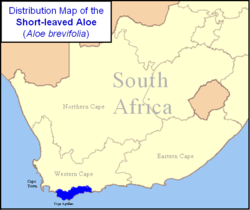| Aloe brevifolia | |
|---|---|
 | |
| Scientific classification | |
| Kingdom: | Plantae |
| Clade: | Tracheophytes |
| Clade: | Angiosperms |
| Clade: | Monocots |
| Order: | Asparagales |
| Family: | Asphodelaceae |
| Subfamily: | Asphodeloideae |
| Genus: | Aloe |
| Species: | A. brevifolia |
| Binomial name | |
| Aloe brevifolia | |
 | |
Aloe brevifolia, the short-leaved aloe, is a species of flowering plant in the family Asphodelaceae. It is a tiny, compact, blue-green evergreen succulent perennial, that is native to the Western Cape, South Africa. Listed as Endangered on SANBI's Red List, it is threatened in its natural habitat, but is also widely popular as an ornamental plant in rock gardens and xeriscapes worldwide. [3]

